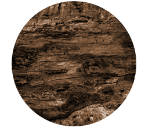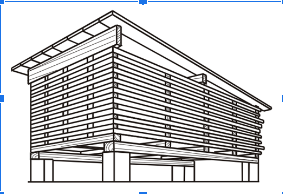Drying and Treatment
Preservative treatment is essential to ensure that the wood has a long shelf life while maintaining its physical properties. To avoid being attacked by wood-destroying organisms, such as termites, fungi or crustaceans, each piece of wood must undergo processes that range from pre-treatment to the application of preservative compounds on its surface and/or throughout its volume. .
Some basic precautions are recommended to avoid the attack of xylophagous organisms and increase the durability of the wood:
- Avoid using wood directly in contact with the ground;
- Avoid use in humid environments;
- Drying to critical point* (around 20% humidity);
- Employ some type of preservative treatment on the wood.
Xylophagous Organisms

They are wood-destroying agents, and are classified as follows:
Termites, more serious wood-destroying agents; about 2000 species in Brazil; live in colonies. They can be divided into underground and non-underground:
- Underground: live in the ground, attack wood with higher moisture content;
- Non-underground: They settle in the wood itself, which is usually (relatively) dry and is more common in urban environments.
Macrofungi, established in the wood through spores carried by the wind and producing hyphae, which penetrate through the surface to the heartwood. Rotting occurs due to the action of enzymes, chemical compounds produced by the fungus;
Crustaceans and molluscs, marine destructive agents that excavate or pierce wood used in contact with sea water;
Staining fungi/molds, do not rot the wood but stain it, causing deep or superficial discoloration, with bluish stains being more frequent; devalue the piece.

Processes prior to treatment
- As a rule, the first step in using wood products should be observing the environment in which the product will be used (moisture, presence of xylophagous agents, contact with the soil/water, etc.);
- With occasional exceptions, wood must always be debarked, cut and dried before being treated with preservative compounds;
- These processes must be carried out to maximize the absorption of the solutions used by the surface and interior of each piece;
- If the cut occurs after the treatment (and depending on the treatment used), internal parts of the wood with less penetration of preservatives can be exposed to attack.
wood drying
It is one of the most important processes for the preservative treatment of wood. Through it, the wood, with much lower humidity, is less susceptible to attack by insects and xylophagous fungi, and becomes more resistant to decay. The wood should be dried to around 20%, reaching its minimum moisture point for use. The drying processes involve manual and industrial phases. Initially, the logs are stacked in a dry area, without direct sunlight, above the ground (with a base of treated wood or other material) and in the form of a grid, allowing the action of the wind. The wood must be stacked for 3 to 6 months, depending on the species and time of year, to reach its ideal humidity for use.
In industrial processes, the wood is placed for drying in an oven compartment, with a temperature just above 100ºC (for evaporation of the internal water) but controlled to avoid burning the solid matter.
wood preservatives

Wood preservatives or preservatives are used to prolong the shelf life of wooden products. These are toxic chemicals that seek to poison the wood to prevent it from serving as food for xylophagous agents. Its use is necessary because there is a minimum humidity that each piece of wood must retain, in addition to the fact that, many times, the pieces will be used in contact with soil and water, being exposed to fungi and insects. To be considered effective preservatives, compounds must have the following characteristics (LEPAGE, 1986):
- Deep penetration into the wood;
- Toxicity to xylophagous organisms;
- Low evaporation;
- Low leaching;
- Low toxicity to humans and domestic animals at its usual concentration;
- Non flammable;
- Not harmful to the environment;
- Low cost.
types of preservatives
They can be divided into two general categories:
- Oil or oil-soluble preservatives: For the treatment of wood used in direct contact with the ground; most important: creosote and pentachlorophenol. Both are quite toxic to humans, expensive, and change the color of the wood (to greenish). Both are obtained and used in industrial processes.
- Water-soluble preservatives: More modern, water-soluble preservatives are made up of the association of various salts. They are easy to transport, safe in handling, and represent a high proportion of the products consumed in the treatment of wood.
Methods of applying preservatives
The preservative treatment of wood can be done in:
- Pressure or industrial processes, which use large cylindrical steel containers where, with the proper use of vacuum and pressure, chemicals with preservative properties are injected into the wood;
○Ex: industrial oven drying; autoclave (vacuum injection)
- Pressureless or homemade processes, simple processes that do not require the use of sophisticated equipment and can be carried out by those interested in using or selling the wood.
Eg: diffusion; sap replacement; brush stroke; pulverization
